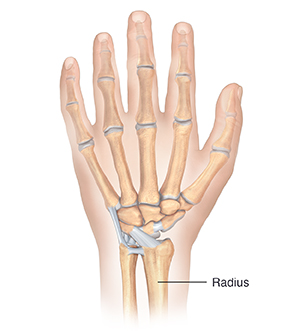A fracture is a broken bone. A fracture in the distal radius is a break in the lower end of the radius. This is the larger bone in the forearm. Because the break occurs near the wrist, it's often called a wrist fracture.
The bone may be cracked, or it may be broken into two or more pieces. The pieces of bone may be lined up or they may have moved out of place. Sometimes, the bone may break through the skin. Nearby nerves, tissues, and joints may also be damaged. Depending on the severity of the fracture, healing may take several months or longer.
What causes a distal radius fracture?
This type of fracture is most often caused from a fall on an outstretched hand. It can also be caused from a blow, accident, or sports injury.
Symptoms of a distal radius fracture
Symptoms can include pain, swelling, and bruising that happen right away. If the bone breaks through the skin, external bleeding and infection can also occur. The wrist may look crooked, deformed, or bent. It may be hard to move or use the arm, wrist, and hand for normal tasks and activities.
Treating a distal radius fracture
Treatment depends on how serious the fracture is. If needed, the bone is put back into place. This may be done with or without surgery. If surgery is needed, the surgeon may use devices such as pins, plates, or screws to hold the bone together. You may need to wear a splint or cast for a month or longer to protect the bone and keep it in place during healing. Other treatments may also be used to help reduce symptoms or regain function. These include:
-
Cold packs. Putting an ice pack on the injured area may help reduce swelling and pain.
-
Raising the arm and wrist. Keeping the arm and wrist raised above heart level may help reduce swelling.
-
Pain medicines. Taking prescription or over-the-counter pain medicines may help reduce pain and swelling. NSAIDs (nonsteroidal anti-inflammatory drugs) are the most commonly used medicine. They may be prescribed or bought over the counter. They may be given as pills. Or they may be applied to the skin in the form of a gel, cream, or patch. Check with your doctor before taking any medicine.
-
Exercises. Doing certain exercises at home or with a physical therapist can help restore strength, flexibility, and range of motion in your arm, wrist, and hand. In general, exercises are not started until after the splint or cast is removed. Follow your doctor's instructions.
Possible complications of a distal radius fracture
Complications can include:
-
Poor healing of the bone.
-
Weakness, stiffness, or loss of range of motion in the arm, wrist, or hand.
-
Osteoarthritis in the wrist joint.
When to contact your doctor
Contact your doctor right away if you have:
-
A fever of 100.4°F (38°C) or higher, or as directed by your doctor.
-
Chills.
-
Symptoms that don’t get better with treatment, or that get worse.
-
Numbness, coldness, or swelling in your arm, hand, or fingers.
-
Fingernails that turn blue or gray.
-
A splint or cast that is damaged or feels too tight or loose.
-
New symptoms.
Author: Yang, Sue
© 2000-2025 The StayWell Company, LLC. All rights reserved. This information is not intended as a substitute for professional medical care. Always follow your healthcare professional's instructions.

